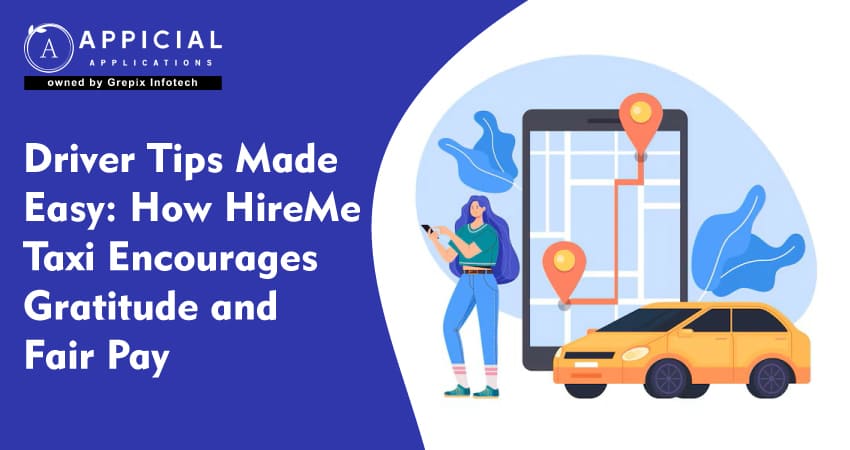
Driver Tips Made Easy: How HireMe Taxi Encourages Gratitude and Fair Pay
In the rapidly evolving mobility sector, drivers are the backbone of ride-hailing, ride-sharing, and e-hailing apps. One of the most under-discussed yet crucial aspects is tipping and fair compensation. The truth is: without mechanisms for gratuity and transparent pay, even the best Uber Clone platforms can struggle with driver retention and service quality. By embedding tipping workflows and fairness metrics, platforms can promote gratitude from riders, improve driver satisfaction, and align incentives.
For any business looking to launch a white-label taxi booking app or working with a white-label or taxi app development company, understanding how to structure tips and pay is essential. This article will examine how HireMe Taxi makes tips easy, why that matters, and what your development roadmap should include.
This blog explores how drivers on the HireMe Taxi platform benefit from a systematic tipping feature and fair pay structure. It explains why tipping matters in the gig economy, how ride-hailing, ride-sharing, and e-hailing apps can implement tipping, how a taxi app development company or a white-label taxi app development company should build the functionality, and why it matters for driver loyalty and platform reputation. The article highlights design considerations, operational models, and statistics on the ride-hailing industry, and ends with a call to action to choose Appicial Applications for building your Uber Clone or white-label taxi booking app.
Why Driver Tips Matter in a Ride-Hailing / Ride Sharing Ecosystem
What role do tips play for drivers?
For drivers on a ride-hailing app, tips represent more than extra income. They represent acknowledgement of service, respect for time and effort, and motivation to maintain higher standards. Studies show that the majority of drivers on gig platforms cite modest earnings and unpredictable pay as major stresses. When a platform introduces an easy tipping feature, it recognises that service quality and driver satisfaction are connected. For a ride-sharing app or e-hailing app, integrating tips differentiates it from pure basic transportation services. In the context of a white label taxi booking app, you gain a competitive advantage by demonstrating driver-friendly policies.
How do tips affect platform reputation and quality?
When drivers feel appreciated, they are more likely to go the extra mile. Better driver behaviour, timely pickups, polite communication—these all follow from higher morale. For platforms building an Uber Clone, maintaining high service standards differentiates you in a crowded market. When users see that drivers are well compensated and tipped easily, they associate the brand with fairness. That improves retention of both riders and drivers.
What are the industry trends for driver compensation and fairness?
In India, the taxi/ride hailing market is expected to grow strongly. For example, the Indian taxi market research shows online booking share at 71.28 % and ride-hailing commanding 65.63 % of market revenue in 2024. As the marketplace grows, platforms must invest in driver-friendly models if they want to scale sustainably. A taxi app development company that ignores tipping and fairness risks building a product that cannot retain partners.
How HireMe Taxi Makes Tipping Seamless and Fair
What system design supports tipping in the app?
HireMe Taxi integrates a tipping module into its driver-ride flow. At the end of each ride, riders are given a simple prompt: “Would you like to tip?” Options include preset amounts and a custom input. This is embedded in the ride hailing app journey so that tipping is intuitive, not hidden behind menus. For an Uber Clone, the design must ensure the tipping UI is unobtrusive but prominent. The backend must track and attribute each tip to the driver’s earnings dashboard. A white label taxi app development company should build this as a core module.
How is fair pay ensured alongside tips?
Beyond tips, HireMe Taxi structures driver earnings clearly. Base fare + per km + waiting time + any extra charges are shown. Tips are added on top. This transparency builds trust. If the driver sees exactly what they earned, including the tip, they feel treated fairly. A robust driver earnings module is essential for any ride sharing app or e-hailing app. A taxi app development company should implement a driver dashboard with detailed breakdowns (rides, tips, commissions).
How are driver incentives and gratitude tied together?
When drivers accumulate high ratings and good customer feedback, the platform issues “Thank You” bonuses and tip multipliers. For example, when a driver’s rating exceeds 4.9 for 50 rides, tips may increase by 5 %. This dual mechanism fosters both gratitude from riders (via the tip prompt) and performance improvement from drivers. For a white label taxi booking app, building such incentive logic strengthens engagement.
What measures protect against misuse and ensure fairness?
HireMe Taxi includes safeguards: no tip baiting, tip revoking is locked after a grace period, and drivers cannot see tip amounts in advance to avoid influencing behaviour. These protections matter in gig economies where algorithmic bias and fairness concerns are rising. A competent taxi app development company should include tip-audit logs, fraud detection, and transparent reporting.
What Are the Benefits of Easy Tipping and Fair Pay for All Stakeholders?
Benefits for Drivers
Drivers receive higher cumulative earnings when tips are easily accessible. They receive recognition, feel valued, and churn decreases. When a ride sharing app gives them clarity on pay and tips, they also trust the platform more. Drivers who feel fairly treated are likely to deliver better service, which improves ratings and in turn earnings. Over 70 % of ride-hailing drivers in some markets report that unpredictable pay is their top concern. With tipping integrated, that concern reduces.
Benefits for Riders
From a rider’s perspective, tipping is optional but easy. They appreciate the service, feel good about rewarding it, and the UI makes it frictionless. When the platform prompts them and shows driver info (name, photo, rating), the emotional impact of gratitude increases. For a ride-hailing app, this improves rider satisfaction, word-of-mouth, and loyalty.
Benefits for Platform / Business
For the platform, encouraging tips and fair pay unlocks multiple advantages. First, improved driver loyalty lowers acquisition costs. Second, higher service quality raises ratings, reducing cancellations and no-shows. Third, in a competitive market (whether you build an Uber Clone or launch a white label taxi booking app), driver-centric policies become selling points. Fourth, when driver earn-out is transparent and fair, regulatory risk and driver protests reduce. In India and beyond, the gig economy is under scrutiny.
Benefits for Investors and Growth
Investors look at sustainability of supply (drivers). An app with low churn, strong driver engagement and fair pay mechanics is healthier. Metrics like driver utilisation rate, tip-per-ride, and driver-rating correlate with long-term viability. When you engage a taxi app development company to design your platform, building tip-and-fair-pay modules early is a strategic investment.
What Are the Implementation Challenges and How to Manage Them?
How to handle tip prompt fatigue?
If every ride prompts tipping in a heavy-handed way, riders may feel pressured or annoyed. The UI should balance subtlety and clarity. Encourage tipping gently rather than forcing. The ride-sharing app design should A/B test variation of tip prompts, preset amounts and optional skip buttons. The white label taxi app development company should guide thoughtful UX flows.
How to ensure transparency and avoid driver distrust?
Some drivers may think tips are withheld, delayed or mis-allocated. The platform must provide clear visibility: “Tip credited – ₹XX; appears in your next payout.” The backend must handle tip reconciliation, payout batching, and driver statements. A poor implementation by the taxi app development company can cause distrust and churn.
How to manage taxation, accounting and local regulations?
In many jurisdictions, tips may have tax implications. The platform must capture tip data, generate driver statements, and provide compliance support. For a global e-hailing app or an Uber Clone, you must consult local labour & tax laws. The taxi app development company should build modules to account for different markets.
What about premium rides, surges and tip expectations?
When fares surge or ride types are premium, riders may expect drivers to provide higher service. That may increase tip expectation or backlash when service is standard. The platform should manage rider communication: “You can tip if you’d like to show extra appreciation.” The ride-hailing app should normalize tipping as optional and driven by quality. Implementation logic by the white label taxi app development company should adapt to fare categories.
How to avoid driver over-focus on tips at cost of fairness?
If drivers chase tips aggressively (e.g., long detours to get higher ratings), that may harm overall efficiency. The system must balance: core fare + fair dispatch + tip bonuses, not just tip chasing. Analytics modules should monitor ride duration, distance, waiting time and flag unusual patterns. The taxi app development company must incorporate these checks.
Which Features Should Your Taxi App Development Company Build for Tipping & Fair Pay?
Driver Earnings Dashboard
Your ride hailing app must include a clear driver dashboard: number of rides, base fare, distance/time breakdown, any incentive/bonuses, tip amount, commission deductions. A white label taxi booking app solution should provide both summary and detailed transaction history. This transparency builds trust and loyalty.
Tip Prompt UI & Logic
The ride-sharing app must include a rider UI after ride completion: driver photo/name, rating, “Thank your driver” prompt, preset tip amounts (for example ₹20, ₹50, ₹100), custom amount, skip option. Tip flows must support multiple payment methods and include a “why tip” message to encourage gratitude.
Tip Crediting & Payout Integration
From the backend side, the taxi app development company must ensure that tip amounts are credited correctly to driver earnings, are visible in the driver wallet/statement, and included in the payout cycle. It must reflect in payroll/booking ledger so there is clear audit trail.
Rating & Bonus Triggers
The tipping logic can be tied to driver performance metrics. For example, when driver rating ≥ 4.8 for 30 rides, tip multiplier or bonus unlocks. The e-hailing app must build rules engine for triggering these incentives. A white label taxi app development company should include configurable parameters for bonus triggers.
Analytics & Monitoring
The platform needs analytics on: average tip per ride, tip percentage of total earning, tip distribution by city/zone, driver categories of high tips, cancellation rate vs tip rate, no-show vs tip rate. These insights help refine the model and must be built by the taxi app development company.
Fraud and Trust Modules
Include tip-audit logs, tip rollback protections, tip revocation limits, driver notification when a tip is revoked, driver dispute module for tip issues. The ride-hailing app must monitor for “tip baiting” behaviour (users offering tip then cancelling) or driver manipulation. This protects trust.
Flexible Payment Options for Tips
Support cashless tips via wallet, card, UPI, etc. Some riders prefer cash tips; the platform should optionally allow or convert them into digital wallet credit for drivers. For a global Uber Clone, local payment methods vary. Your white label taxi app development company should build modular payment gateways.
How to Market the “Tip & Fair Pay” Feature to Drivers and Riders?
Messaging to Drivers
Tell your drivers: “Earn more with happy riders. Our tipping feature rewards your great service.” Provide training materials, in-app notifications, and driver portal banners. Use data: highlight the average tip per ride in your region. Explain transparency: “See your hits, no hidden commission on tips.” A ride-sharing app must communicate this to drivers clearly.
Messaging to Riders
Riders should be informed: “Want to say thanks? Add a tip in seconds.” During app onboarding, include tip information. Highlight statistics: “X % of our drivers earned extra tips last month.” Frame tipping as a simple thanks, not mandatory. This helps maintain a positive feel and avoid pressure. For a ride-hailing app, this helps boost tip adoption.
Promotional Incentives
Run campaigns: “Give a ₹50 tip this week, get a ₹20 coupon next week.” Or “Top-tipped drivers win gift cards.” Use notifications and push marketing. When building your white-label taxi booking app, ensure these promotional workflows are in place. A taxi app development company should include support for such campaigns.
Branding and Competitive Advantage
When your platform highlights driver-centric policies (transparent pay, tipping, fairness), you stand out among Uber Clone competitors. Market narratives: “We value drivers. You value riders.” Emphasise that your ride-hailing app treats drivers as partners, not just gig labour. This helps attract better drivers and loyalty.
Evidence and Social Proof
Publish driver testimonials about tips and earnings. Show statistics like “average tip per ride $10.” For example, you might say: “Over 55% of all rides this month had tip added.” While exact numbers will vary, including such social proof builds credibility. For the ride-sharing app buyer considering your platform, this is a strong signal.
Why Partner with Appicial Applications for Building Your Driver-Tip & Fair-Pay Enabled Platform?
When you decide to launch your own Uber Clone, ride-sharing app, or e-hailing app, selecting the right partner matters. A generic solution won’t cut it—especially when you’re focusing on drivers and tipping. That’s where Appicial Applications comes in.
Deep Domain Expertise and Built-In Modules
At Appicial Applications, we have built multiple platforms in the mobility space. Our team understands the mechanics of driver incentives, gratuity flows, fair pay dashboards, driver statements, and analytics modules. We can deliver your white label taxi booking app with tipping and pay transparency embedded from day one.
Tailored for Both Riders and Drivers
We don’t just build rider-facing apps; we build driver modules, dashboard, payouts, tip handling, and incentives. A dedicated taxi app development company like ours ensures both sides of the marketplace are optimized.
Scalable Architecture for Growth
Whether you start with one city or launch globally, our architecture supports tipping workflows, driver statements, campaign logic, fraud protection and analytics. As a white-label taxi app development company, we give you code ownership, branding control, and extensibility.
Go-to-Market Speed and Flexibility
With our ready modules and expertise, you can launch faster than building from scratch. For your ride-hailing app, we include toggles for tip modalities, driver bonus rules, payment gateways, and analytics dashboards. We adapt to your region, local payments, local labour laws, and cultural norms.
Post-Launch Support and Optimisation
After launch, we help you monitor tip adoption, driver churn, performance metrics, and optimise. Want to test different tip prompts or bonus triggers? We handle it. We remain your partner, not just a vendor.
Ready to build a tipping-enabled ride-hailing platform that honours drivers and delights riders? Choose Appicial Applications today. Contact us for a free consultation and demo. Let us help you launch your own Uber Clone or white label taxi booking app with driver tip and fair pay features built in.
Conclusion
In the competitive mobility market, the difference between a good and a great platform often comes down to how you treat your drivers. Easy-to-use tipping, transparent earnings, and fair pay matter not just for morale; they translate into better service, lower driver churn, higher ratings, and more reliable operations.
Whether you are developing a ride-sharing app, e-hailing app, or building your own Uber Clone, integrating robust tip and pay systems is non-negotiable. Partnering with an experienced taxi app development company or white label taxi app development company ensures these critical modules aren’t an afterthought. With Appicial Applications, you get a full-stack, driver-centric solution designed for scale and trust. Launch now and make your platform both rider-friendly and driver-friendly.
FAQs
Author's Bio

Vinay Jain is the Founder at Grepix Infotech and brings over 12 years of entrepreneurial experience. His focus revolves around software & business development and customer satisfaction.
Back to blog list




